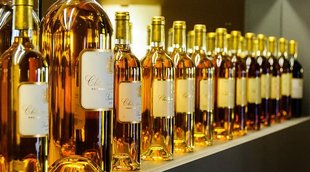Guide to Sauternes, Bordeaux: 10 Best Wines To Buy in 2025
Sauternes represents the rarer, sweeter side of Bordeaux wine. With their complexity and zesty acidity, these wines work perfectly as aperitifs and as dessert wine options.
Sauternes wine can age beautifully, making it an excellent investment wine as well.
In this article, you’ll discover everything about Sauternes wine, including its tasting notes, ten luscious Sauternes bottles, Sauternes food pairing, Sauternes’ climate and geography, and the winemaking process.
You’ll also discover a brief history of the region’s wines.
Further reading
- You've got to try out some of these delicious Sweet Wines handpicked from around the world!
- Check out the most elegant White Wine Bottles you need to get hold of!
A Quick Intro To Sauternes Wine
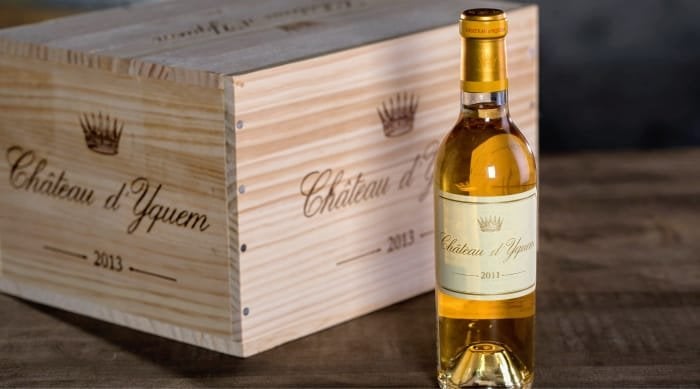
Sauternes wine is produced in the Sauternes appellation (Sauternais in French) in Bordeaux, France, and is an expensive and high-quality white wine.
This wine is a blend of three white grape varieties:
- Semillon is the main grape varietal used in Sauternes wines. The Semillon grapes have thin skins, so they easily get infected with the Botrytis fungus. Semillon adds texture to Sauternes wine.
- Sauvignon Blanc is less prone to developing noble rot. About 25% of all Sauternes vineyards are planted with Sauvignon Blanc. This grape variety adds more acidity and crispness to the Sauternes wines.
- Muscadelle is the third grape variety added to the Sauternes wines. Muscadelle grapes are hard to grow since they develop noble rot and other grape diseases. It adds a light floral aroma to the wine blend.
What makes this wine different from other dessert wines is noble rot. This rot is caused by the fungus Botrytis cinerea, which increases the wine’s natural sweetness.
Sauternes Wine: Taste And Characteristics
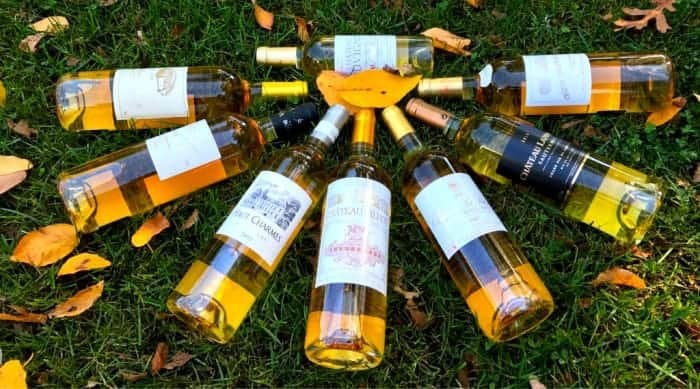
Sauternes wines have a deep yellow hue with an elegant balance of sweetness and acidity.
It has dried apricot, caramel, tropical fruit, and honey notes, followed by a long-lasting finish and nutty undertones.
A bottle of Sauternes dessert wine can have 120–220 g/L of residual sugar.
10 Luscious Sauternes Wines To Buy In 2024 (Including Tasting Note, Prices)
Here are 10 must-try Sauternes wines for sweet wine lovers.
- 1959 Chateau d'Yquem
- 1956 Chateau Filhot
- 1957 Chateau Climens
- 2001 Denis Dubourdieu Chateau Doisy-Daene L'Extravagant de Doisy-Daene
- 1990 Chateau Coutet Cuvee Madame
- 2001 Chateau Caillou
- 2014 Chateau de Fargues
- 2003 Chateau Haut Bommes
- 2004 Chateau Rieussec
- 2017 Chateau Coutet
1. 1959 Chateau d'Yquem, Sauternes, France ($2,596)
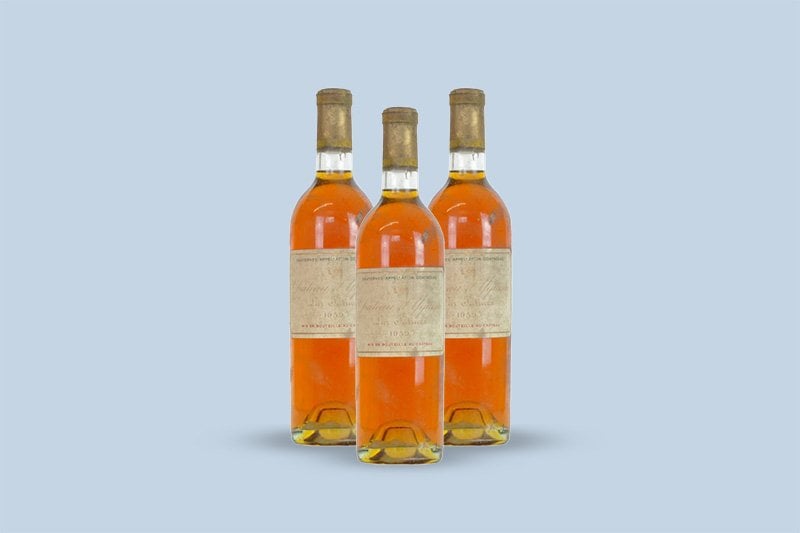
The 1959 Yquem sweet wine has an utterly profound bouquet of orange marmalade, dried fruit, honeyed nuts, creme brulee, and new leather. The palate brings forward great minerality and gentle candied orange peel notes.
2. 1956 Chateau Filhot, Sauternes, France ($1,320)

In the glass, this Bordeaux wine showcases a deep amber color. The nose gives off candied fruit, caramel, dried fruit, oak, and orange peel aroma.
3. 1957 Chateau Climens, Sauternes - Barsac, France ($1,224)

This sweet white wine is graceful and weightless with a subtle tightness and minerality. This sweet Bordeaux packs an aromatic palette of flowers, tropical fruit, and orange marmalade.
4. 2001 Denis Dubourdieu Chateau Doisy-Daene L'Extravagant de Doisy-Daene, Sauternes - Barsac, France ($611)
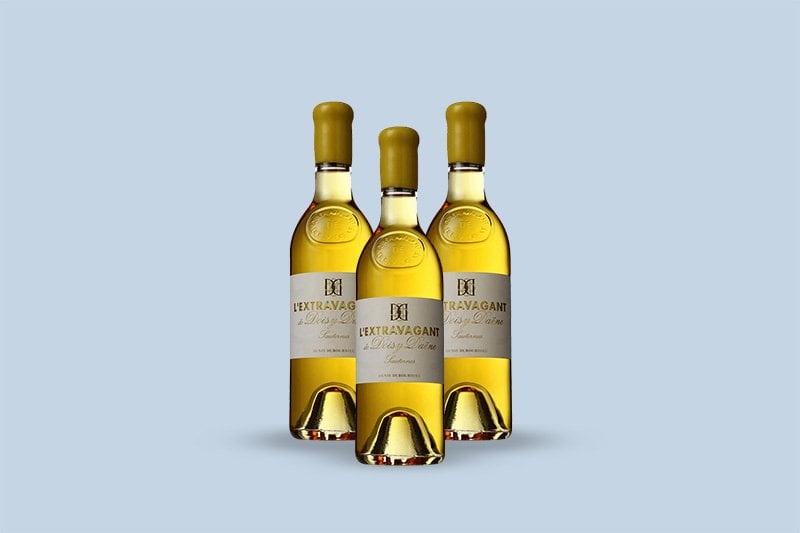
It is a delightfully sweet wine with a pure floral aromatic nose followed by a crisp, balanced palate with delicate citrus fruit flavor and hints of crystallized pineapple.
5. 1990 Chateau Coutet Cuvee Madame, Sauternes - Barsac, France ($634)

The sweet wine is rich and powerful and offers a profound bouquet of smoky, toasty new oak with honeyed pineapple and apricot notes. The palate showcases a bright acidity.
6. 2001 Chateau Caillou, Sauternes, France ($74)

This elegant and nicely nuanced sweet white wine displays a lovely saline finish. Wine tasting reveals a touch of acidity and good length on the palate.
7. 2014 Chateau de Fargues, Sauternes, France ($216)
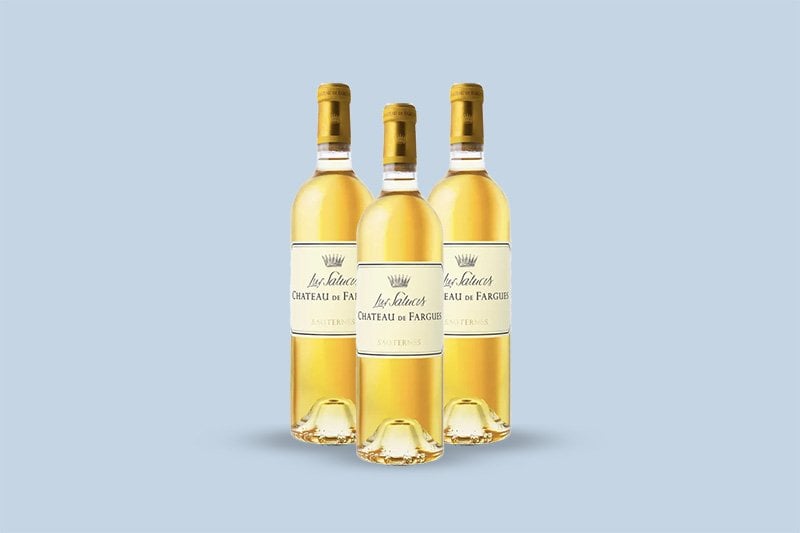
This Bordeaux wine is crisply poised with a rich fruit and honey flavor and intense acidity.
8. 2003 Chateau Haut Bommes, Sauternes, France ($40)
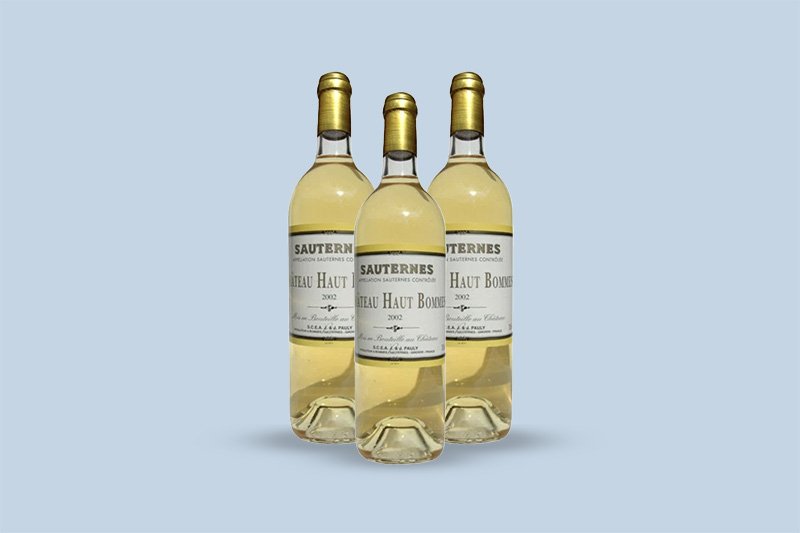
This 2003 Bordeaux has exceptional nectars with a complex aromatic palette of citrus fruit, honey, and candied fruit notes.
9. 2004 Chateau Rieussec, Sauternes, France ($56)

This Bordeaux wine is exceptionally fruity with lemon, dried apricot, and lilac aroma. Full-bodied on the palate, this Bordeaux presents lovely minerality and bright acidity.
10. 2017 Chateau Coutet, Sauternes - Barsac, France ($49)
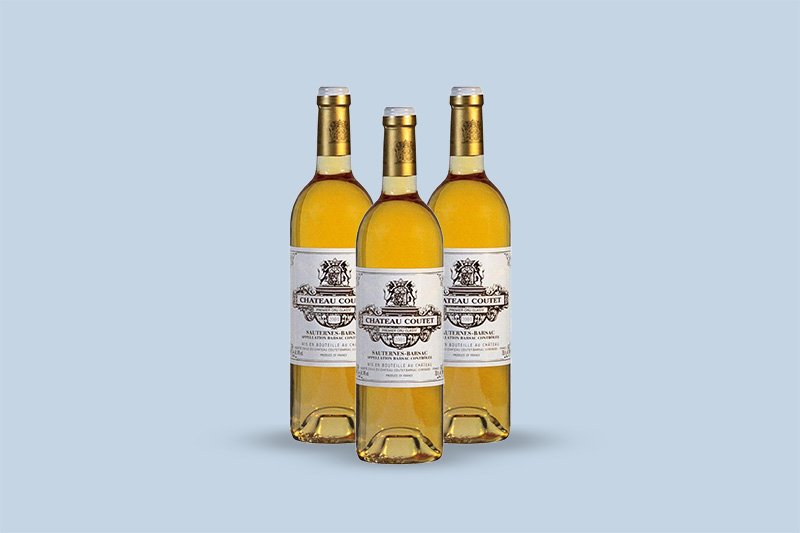
This light, pale Barsac wine offers great complexity with notes of citrus, ginger, apricot, and white flowers. Wine tasting reveals a balanced palate with a long finish.
Should You Invest in Sauternes Wine?
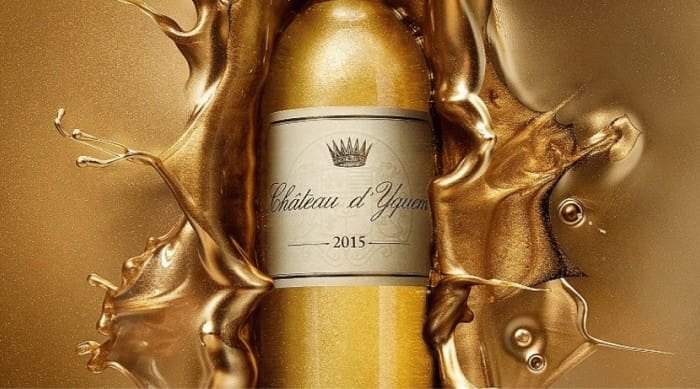
Thanks to the high sugar content and the oxidation of grapes because of the noble rot, a bottle of Sauternes can age harmoniously for 20-50+ years.
Of course, it also depends on the vintage and wine storage conditions.
With time in the bottle, the wine develops an intense dark gold color, and the flavor becomes more mature and complex.
You’d often spot Sauternes wines sold at enviable prices at auctions, especially those from the prestigious Chateau d’Yquem. For example, a 1787 vintage Chateau d'Yquem fetched over $100,000 in a 2006 auction.
The best Sauternes wine vintages to look out for are 1990, 1996, 1997, 2001, 2003, 2005, 2009, 2010, 2011, 2013, 2014, 2015, 2016, 2017, 2018, and 2019.
But how do you acquire a bottle of Sauternes wine? Finding an authentic bottle of this coveted wine isn’t an easy task at all!
Luckily, you can easily get the sought-after Sauternes wine and other collectible wines through a trusted wine investment platform likeVinovest!
How To Serve Sauternes Wine (Including Sauternes Food Pairing)

Sauternes sweet wine is typically served chilled (at 10°C) and pairs well with savory dishes like foie gras, blue cheese, or a more traditional roasted poultry dish with spices.
Dessert dishes like tiramisu also work well as Sauternes wine pairing.
More often than not, you’ll find Sauternes in a half bottle size of 375 ml because it’s expensive to produce. However, they also come in larger bottles.
But, where are these deliciously sweet wines made?
The 5 Communes Of Sauternais
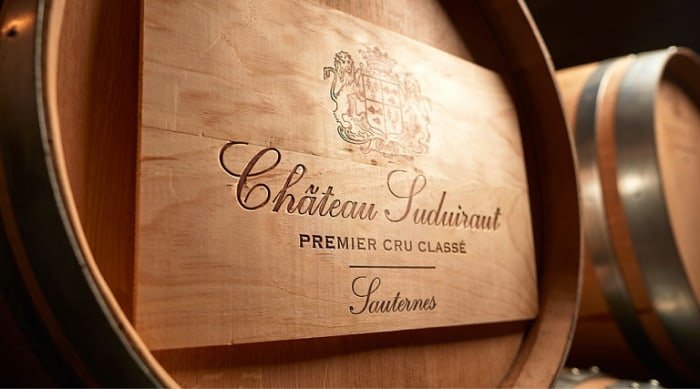
There are five communes in the Sauternes wine region:
- Barsac: The Barsac commune is allowed to label its wines both as Sauternes or as Barsac appellation. One of the most famous wines from Barsac is the one labeled as Sauternes - Barsac wine.
- Sauternes: The whole Sauternes region is named after this small village, which is 30 miles from Bordeaux.
This commune is home to the most reputed Sauternes wine chateaux - Chateau d'Yquem. Yquem is known to produce the best Sauternes wine and is the only one designated as a Premier Cru Supérieur (Superior First Growth) chateau.
- Bommes: A beautiful commune where the Chateau Lafaurie-Peyraguey is located.
- Fargues: This commune was not always part of the Sauternes region. It was added to the appellation in 1921.
- Preignac: This small commune is home to the famous Sauternes vineyard Chateau Suduiraut.
All of the communes fall under the Sauternes AOC.
Sauternes Wine Region: Climate And Geography
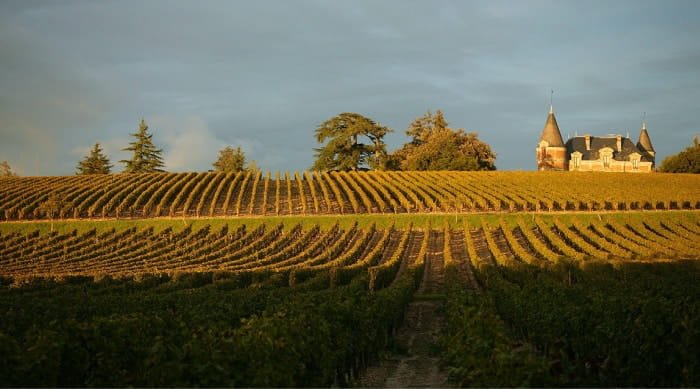
The Sauternes region is part of the Graves district situated 25 miles southeast of Bordeaux. The terroir of most Sauternes vineyards is chalky with limestone, clay, gravel, and sand.
With unpredictable hails, frosts, and high humidity levels, its maritime climate often exposes the grapes to different grape diseases and mold.
Also, the Sauternes region is situated between the Ciron and Garonne rivers. Since the two rivers have different water temperatures, they form early morning mists that transition to warm and dry afternoons.
This creates the perfect conditions for the growth of the Botrytis cinerea fungus.
Once the Botrytis fungus is formed on the grapes, it gets into the grape skin, developing noble rot. Noble rot dries the grapes, reducing their water content. In turn, the sugars and grape flavor gets more concentrated and intense, creating a vibrant and flavorful wine.
The unique microclimate in the Sauternes region helps maintain the benevolent noble rot fungus, preventing it from becoming grey rot (which gives a bad sour taste to the wine).
It is one of the reasons why producing Sauternes is so complicated.
Unique Sauternes Winemaking Practices

Producing Sauternes wines is an expensive and time-consuming process.
- The grapes are prone to different diseases if they are left on the vines for longer or if the climate is harsh.
- Picking the grape bunches with Botrytis cinerea is a tedious process. Vineyard workers have to go around the vineyard multiple times to check which grapevines are affected by Botrytis and ready to be picked.
- Once the grapes are picked, winemakers use a vertical or pneumatic press to extract the grape juice.
- The fermentation takes up to 18 to 36 months. Prestigious winemakers age their Sauternes wine in expensive oak barrels, while other wine estates ferment the wine in stainless steel tanks.
- It’s also important to note that Sauternes wines are not released every year. Some of the years have bad weather, which does not allow the Botrytis fungus to develop properly.
These factors add to the Sauternes’ price and make it one of the most expensive white wines in the world.
Further, according to the AOC regulations, a wine can be classified as Sauternes only if it:
- Has at least 13% ABV.
- Comes from yields of a maximum of 25 hectoliters.
- Is made using grape must with 221 grams of sugar per liter.
- Passes a tasting exam for sweetness levels. However, there is no exact amount of residual sugar the wines must contain.
Other regions that produce similar wines are Cadillac, Loupiac, and Cerons. These wines are also a blend of Semillon (affected by noble rot), Sauvignon Blanc or Sauvignon Gris, and Muscadelle grapes.
However, they’re less aromatic, and you can find them at more affordable prices.
A Brief History of Sauternes Wine
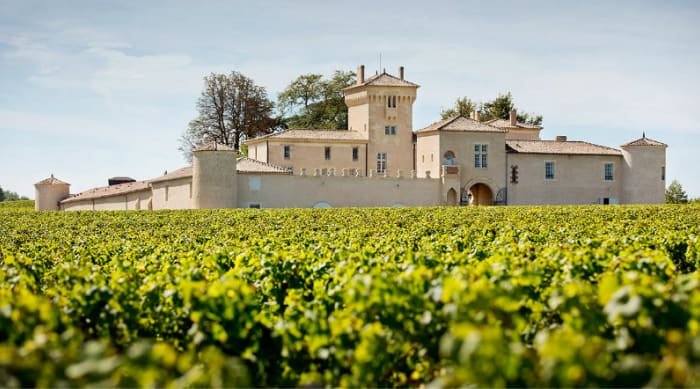
Even though French wine production dates back to the 6th century BC, sweet wine started gaining popularity much later - at the beginning of the 17th century.
The French exported wine mainly to England, where dry white wine and red wine were most preferred.
Meanwhile, in Germany, wine production declined in the 17th century due to the increasing preference for beer. So, the Germans started looking to import wine from elsewhere.
They got interested in the French white wine from Sauternes, Bordeaux, and began investing in the Sauternes vineyards. They even introduced the French to some German winemaking techniques to preserve excess sugars in the wine to add more sweetness.
The first records of noble rot date back to the 17th century. Sauternes producers were separating the botrytized grape bunches from the good ones.
However, the use of these grapes in the winemaking process was kept a secret since the thought of drinking wine from Botrytis-infected grapes was not very appealing.
In the 18th century, the use of noble rot became widely known. Since then, it’s been used widely in making French, German wine, and Hungarian wine.
At the end of the 18th century, American President George Washington placed an order for 30 dozen bottles after tasting the famous Sauternes wine Chateau d'Yquem. This brought global acclaim to Sauternes wine, and there was no looking back since then!
Ready to Add an Exquisite Sauternes Wine to Your Collection?
The sweet, complex Sauternes wine is one for your cellar - for its rich, layered flavors and its age-worthiness!
But, you shouldn’t have to fret over prices, storage, shipping, and other nitty-gritty to get hold of the best bottle of Bordeaux, Sauvignon Blanc, Cabernet Sauvignon, or any other wine from a prestigious winery!
Simply sign up to the Vinovest platform and start building your wine portfolio right away!
